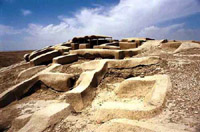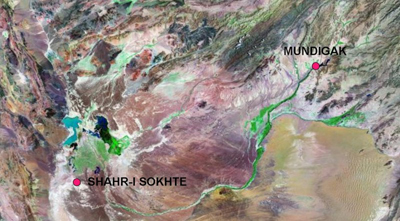
3rd Millennium BC Artificial Eyeball Discovered in Burnt CityCHN News Tehran, 10 December 2006 (CHN Foreign Desk) -- Archeologists in Burnt City announced unprecedented discovery of an artificial eyeball, dated to 4800 years ago, in this historic site. Announcing this news, director of Burnt City archeology excavation team, Mansour Sajadi, said that this eyeball belongs to a sturdy woman who was between 25 to 30 years of age at the time of death. Skeletal remains of the woman were found in grave number 6705 of Burnt City's cemetery.  Regarding the material used to make this artificial eyeball, Sajadi said: "The material this artificial eyeball is made of has not yet been determined and will be assessed through later testing. However, at first glance it seems natural tar mixed with animal fat has been used in making it." Initial studies on the eyeball also suggest formation of an abscess in the eyelid due to long-term contact with the eyeball. Moreover, remaining eyelid tissues are still evident on this artificial eyeball. According to Sajadi, even the most delicate eye capillaries were drawn on this eyeball using golden wires with a thickness measuring less than half a millimeter. There are also some parallel lines around the pupil forming a diamond shape. Two holes are also seen on the sides of this eyeball to hold it in the eye socket. Initial anthropological studies on the remaining skeleton of the woman to which this artificial eyeball belong revealed that she was a hybrid woman who died 4800 years ago between the ages of 25 to 30.  A number of clay vessels, ornamental beads, a leather sack, and a bronze mirror have also been found in the grave of this woman. Located 57 kilometers from the city of Zabol in Sistan va Baluchistan province, southeast Iran, Burnt City is one of the most important prehistoric sites of the country which was well developed during the third millennium BC. Spreading over a 300,000 hectare area, Burnt City was recently recognized as mainland-Iran's largest prehistoric site. The city experienced four stages of civilization and was burnt down three times, which is why it was named 'Burnt City.' Discovery of hundreds of historical sites including 166 satellite villages together with large numbers of archeological relics, skeletons, and ancient structures in the archeological site of Burnt City makes it holder of an unparalleled record in the history of archeological activities in Iran.
|